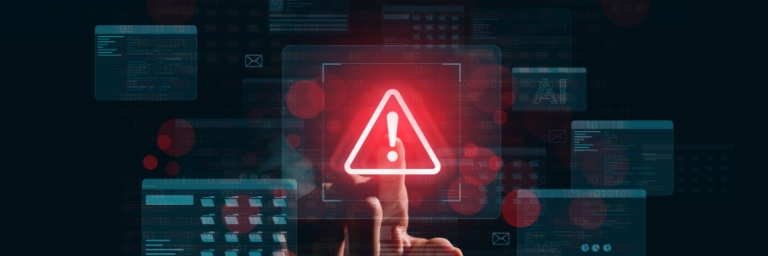Complex cyberattacks with cutting-edge technology and an army of cybercriminals behind them are typically only problems for large enterprises, but that doesn’t mean your SMB (small or medium-sized business) is safe. SMBs like yours are the favorite target of cybercriminals because they generally underspend on cybersecurity, leaving them open to more common cyberattacks that are easier to execute.
Here are the most common (and therefore, most damaging) network security threats that your SMB should be constantly looking out for.
The cyberthreats SMBs most commonly face
In this context, a “threat” is not just a specific type of malware or attack, but instead a source of high risk. Just because you are not currently under attack it doesn’t mean there are no threats to your organization’s IT network and sensitive data.
As such, you should constantly be on the look out for serious threats, and regularly audit your cybersecurity posture to determine how much risk these threats pose to you and what can be done.
Phishing attacks
Phishing is one of the most common cybersecurity threats, and have cost SMBs more money than any other due to how simple they are to execute. Attackers send deceptive emails pretending to be trusted contacts, tricking employees into clicking malicious links or providing sensitive information.
Your employees are the main cause of phishing attacks, but they’re also the best defense against them. Cybersecurity training teaches employees to spot suspicious emails and to avoid clicking on links and attachments in unsolicited emails. The use of email filtering solutions can also help your SMB prevent phishing risks from reaching your inboxes in the first place.
Ransomware
Ransomware encrypts your critical business data and demands payment for its release. Ransomware attacks commonly target SMBs, which often lack strong backups, making them vulnerable. Regularly backing up your data with robust, automated data backup and disaster recovery tools will mitigate much of the damage of ransomware attacks.
Unsecured Wi-Fi networks
An unsecured Wi-Fi network is an open invitation to hackers, and it’s especially dangerous if you operate a public brick-and-mortar location. Without proper encryption, cybercriminals can intercept sensitive business information or even launch more cyberattacks. Securing your network with strong passwords, WPA3 encryption, and hidden SSIDs strengthens security, but don’t forget regular maintenance and security patches.
Weak passwords and poor authentication
Many cyberattacks (still) succeed because of weak passwords. Employees reusing passwords across multiple platforms or failing to regularly update them increases the risk of network intrusions.
Implementing multifactor authentication (MFA) and requiring strong, unique passwords helps reduce this risk. If your workforce must manage multiple passwords across a variety of apps, consider a password manager such as Dashlane or NordPass.
Insider threats
Not all threats come from the outside. Disgruntled employees might intentionally cause damage, and careless workers can unwittingly leave your network open to data breaches.
Limiting employee access to critical systems and using monitoring tools can help detect and prevent insider threats. If an employee does not need access to certain data and systems to perform their function, then they should not have access to them.
Outdated software and unpatched systems
Hackers exploit outdated software to gain unauthorized access to their target’s systems, because these older versions have security vulnerabilities that are not yet fixed. Regularly checking for and applying patches for your operating systems, software, and firmware ensures vulnerabilities are minimized. Automated patch management solutions can simplify the process, but patch management should still be part of your regularly scheduled IT audits.
IoT device vulnerabilities
IoT (Internet of Things) devices, such as smart cameras and thermostats, often lack robust security despite being connected to your network. Unsecured IoT devices are significant cyberthreats because they can be entry points for network intrusions, or they can be hijacked by cybercriminals to spy on or cause damage to your company.
Changing default passwords and segmenting IoT devices on a separate network helps mitigate risks. When buying IoT devices, carefully research their security features instead of connecting the cheapest product available to your network.
Need to know what network risks are putting your organization in danger?
outsourceIT’s experienced cybersecurity consultants can audit your entire network to find and address the vulnerabilities threatening your business. We can also recommend, implement, manage, and maintain cybersecurity tools tailored to your needs so you can focus on your core operations, safe in the knowledge that you are protected by the experts.
Contact outsourceIT for a free consultation!

